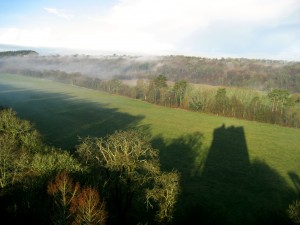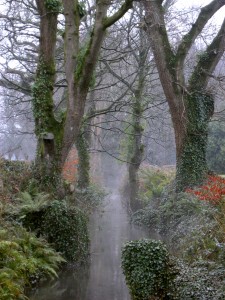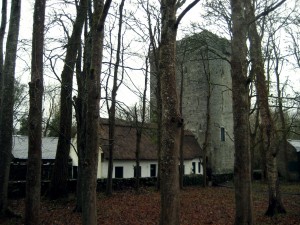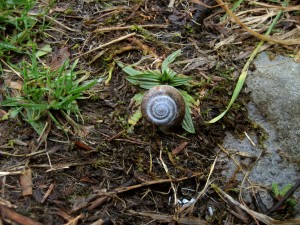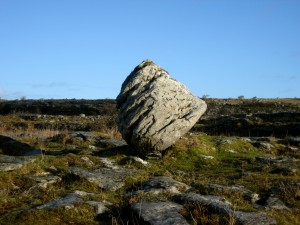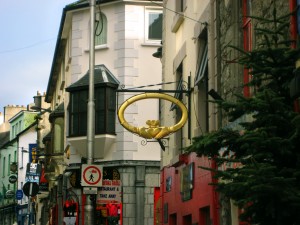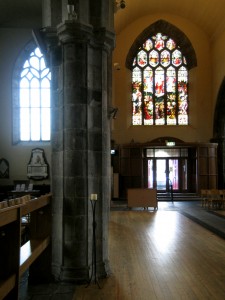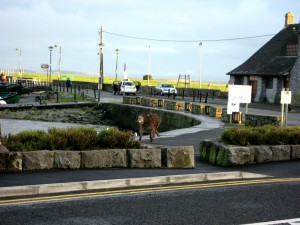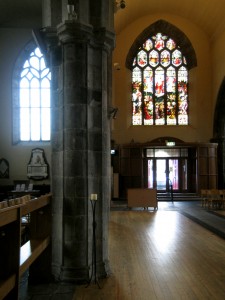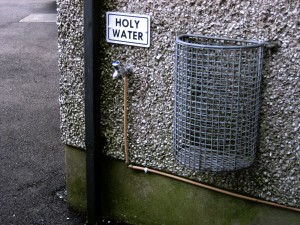Home Away From Home
Over the past few weeks I have seen and experienced the multitude of emotions that come in visiting a new country. I have been in wonderment of the typical sights, sounds, and day to day exploits that come with the prospect of visiting somewhere new, but there is something I have lacked and come to appreciate on my journey. Being a visitor comes with the innate sense of being lost in a new land miles away from where I call home. The feeling is different from homesickness as the longing for familiarity does not affect my functional ability, but rather brings about an appreciation for what is given and what can be called a home.
Arriving in Ballyvaughan, we entered cold cottages with small fireplaces as the only source of warmth on nights of harsh wind and undrying rain. While somewhat uncomfortable at first, the presence of the hearth was appreciated, and comfort was found in good company, along with a few extra layers of warm clothing. Possessing all the comforts of home made this temporary residence become a haven amongst the winter rains of the Burren. I looked toward my cottage as a home base, a place to return to, a constant in an unknown land. As visitors we must always remember the value of the conveniences put in place by residents to assure the welcome feelings we receive in our travels. Even the small town we stayed in became a highlight of the journey due to the familiar nature it began to develop as time went on.
Ballyvaughan is tiny and secluded, and by first impressions has little to offer in a traditional traveler’s mind. However, there is a charm I came to know and love that had me vexed and spellbound by the village. Despite the small size Ballyvaughn had a great personality found in the people present in the streets, shops, and pubs. All around me were new faces, happy to see me, ready and willing to share their own stories and listen to mine as well. It was a grand welcome, not with trumpets and heralds, but with the kind, genuine hospitality and charm only found in a small town.
What made Ballyvaughan a home was not simply the presence of the cottage, but the everyday lifestyle and welcome to the village received upon arriving. The locals were used to college students from all over the world taking refuge in their town, and they knew the value of hospitality. I had heard of the snobbish European stereotype who looked down on the inferior, stupid Americans, but this appears to have skipped Ireland altogether. Everyone we met was ready and willing to talk with us, or help us in any fashion. From Brian the bus driver, Margaret the bartender, to Robert the jack of all trades we were given a true Irish experience in the people present throughout Ballyvaughan. We were told stories of the history of Ireland, listened to, and had a guardian angel of sorts already fixing anything breaking down in the cottages before we even told him. Even a smile and a “good evening” from a stranger walking their dog was enough to make me feel at home and cared for, which made Ballyvaughan feel like home to me. When I left Ballyvaughn to see other parts of the country my appreciation for it as a home only grew.
Galway, Cork, Limerick. As the time transpired in each of these cities I felt them all begin to blend into one. I did not feel the homely appeal found in Ballyvaughn, but only places to come, pass the time, and leave. Cities were meant to be lived in, and become peculiar to visit once one has no business in them. Once all the pictures were taken, gifts bought, and sights seen, there was nothing to do but go home, and since our home was not in the city in question, the lack of purpose and growing isolation amongst vast crowds became overwhelming. Some solace was found within the pubs, but even there the desire for more familiar surroundings proved too much, and I found myself wanting to be back at Logue’s listening to Thriller, YMCA, and We Built this City on repeat while enjoying a frosty pint of Guinness.
Perhaps the most memorable bus ride I had was my return from Cork. The outside air had become drowned in the darkness of night and washed with the rains I have become accustomed to. All the while I thought of home, and what came to mind was the humble cottage in Ballyvaughn. Despite the frigid floors, saturated air, and howling winds just outside, the prospect of familiar faces with a sincere interest in where I had gone on my travels. Time to unwind with friends and share the new stories created in living day by day. This is all I could think about on the bus, and I was unfazed by the winding road and the implausible speed the driver cruised with. A tunnel vision ready to return to the cottage I have grown to call home.
As the days left dwindle to a close, my feelings toward leaving are vast and conflicting. I have enjoyed every minute in Ireland, but I know I must go on. This is not my home despite what it has been in the past month, and I must come to terms with my passing back across the ocean. I have seen the beauty and majesty of the land, experienced the sincerity of those who do call it home, and yet this is only a small fraction of what the land offers. I will return someday and make new memories, but for today I am ready to go home. When I return I am sure my appreciation for my real home will be renewed. I will be full of new stories to share with the ones I care about most in the town I know so well.
Ireland: Evolving Toward the Future, Holding on to the Past
I came to Ireland not looking for anything in particular. Lacking all expectation, I was free to see a country for how it is without exterior distortions affecting my mind. What I found was a land of good humor and sunny personality despite rainy conditions. But behind this was a dark underbelly at the heart of its history, still visible in subtle glimpses even today. Oppression, famine, and poverty over hundreds of years can and will never be forgotten, but their memory must also not become the identity of the nation that has overcome them. Instead, Ireland has proved time and time again that their identity is found when the smallest of cheerful memories outshine the anguish around them. What Ireland gained in its independence was not just the ability to govern itself, but also the opportunity to let the subdued happiness that has always been present become the overarching theme the entire Island shares.
The Irish mantra has always been one which celebrates the joys of life and company even under the most exasperating circumstances. Perhaps this stems the Irish knowledge of a history beyond themselves found within primeval stories such as those of the faeries. Looking back on the ancient lore of Ireland, we see unique tales of identity, forming a bond with the land before history even began to be recorded. These stories helped explain the presence of some of Ireland’s most ancient structures, such as tombs and ring forts, and were often cautionary which shows the Irish reverence toward history. Stories for everything have delighted, suspended, terrified, and inspired children around the warm fires of humble shacks for generations. While always the same stories, they differed from region to region based on innumerable story tellers reeling, contorting, and branding the details to their individual liking. The stories would again evolve with the times, reflecting the hardships experienced by the masses. These stories sustained the population during times of famine, war, and oppression, and for that reason they are held in high regard even today.
Ireland has a curious modern relationship with the ancient structures scattered throughout the island. Ring forts, for example, were once believed to be made by the fairies, and even though this is not historically true, many farmers will often leave these forts in the middle of their fields. Whether this is out of respect of history or the supernatural is something you would have to ask the farmer. While ring forts often seamlessly blend into the land due to their large area and eroding walls made of either dirt or stone, the castles present in Ireland were built to stand out. These great monoliths are only hollow shells of what they once were. Most of them lie abandoned, crumbling, waiting for the stones of the battlement to be reunited with the ground they came from. Others have been refurbished for tourists to enjoy, but they have no practical use anymore. They serve as reminders of numerous pieces of Irish history: houses of landlords good and bad depending on how much is still standing, a wealthy family’s residence, seats of old kings, all have countless stories to tell. Yet there is no story teller besides the rock around it, and what old records can be mustered out of the shelves of a library. Their memory however is integral to the Irish experience as prominent reminders of how the Ireland that is today came to be.
Every inch of Ireland has a story to tell, a history all its own and a unique flare all its own. Every city is intertwined with the roots of the past. Dating back hundreds of years, the cities have grown and evolved from their historic beginnings and have transformed with the times. From cruel medieval times where the smallest of crimes were punishable by death, the extreme poverty and desperation seen in the Potato Famine, and the emerging city of the future seen today, Ireland’s cityscape continues to evolve forward. At the same time, you can see pieces of the past mixed in with the fabrications of the future. Old houses of lords turned into banks, shopping malls containing portions of the old city wall, the home of an executioner turned into a night club, the strangeness of history reaches a pinnacle in Ireland. The respect and reminiscence in each city is apparent, as no city can strive for the future without coming to terms with its past. While the remorse of the past is prevalent once delved down into, the historically happy side of Ireland is still seen in each and every pub playing songs in tune with the antiquity of the country.
On streets and pubs throughout the city musicians of all varieties can be heard playing their own unique tunes. Some offer covers of rock and roll with indisputable Irish influence, while others share traditional tracks with fiddle, accordion and guitar. This music has been present for all the history of Ireland and the two can never be separated. Music to reflect on times of sorrow, bring about joy in one’s life, and to reminisce about the people and the times long past are essential to Ireland. These warm harmonies overpower the depths of rainy winter and show a picture of the indomitable Irish spirit. Through even the hardest of times, these songs have echoed through the streets, raising spirits and placing within them pride for who and what their country is.
I found myself enthralled by three musicians in a pub in Galway. All were capable singers, able to be heard in the back of the bar with no audio equipment. With songs of pride and legacy, they made the pub warmer simply through singing, and were capable of bringing complete silence throughout the raucous pub. A young man from the Aran Islands put down his accordion and began to sing alone in Irish. A slow and haunting melody overtook the pub, and all the patrons were transfixed on this young man singing an old tune. While I had no idea what he was saying, it was clear that the crowd with all ears pointing his direction did, and it was then my senses realized a piece of the Spirit of Ireland. Relics of the past will survive as long as the future depends upon them.
